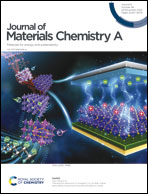High-performance solid-state hybrid supercapacitor enabled by metal–organic framework-derived multi-component hybrid electrodes of Co–N–C nanofibers and Co2−xFexP–N–C micropillars†
Abstract
In recent years, much effort has been devoted to developing hybrid supercapacitors due to their capability to deliver both high energy and power density. The hybrid approach is advantageous in terms of reinforcing the synergic combination of the properties of different components in a hybrid composite. However, a large kinetic mismatch existing between the fast capacitive and sluggish battery-type electrodes greatly hinders its advancement. In this work, we report the fabrication of a solid-state hybrid supercapacitor (SSHSC) device using metal–organic framework (MOF)-derived cobalt-embedded N-doped carbon nanofibers (Co–N-CNFs) and Co2−xFexP–N–C micropillar arrays grown on Ni foam (Co2−xFexP–N–C/NF) as multi-component hybrid electrodes with improved charge storage kinetics. Such Co–N-CNFs (negative electrode) exhibited a remarkable specific capacitance of 280 F g−1 at a current density of 1 A g−1, while Co2−xFexP–N–C/NF (positive electrode) exhibited a high specific capacity of 345 mA h g−1 at a current density of 1 A g−1 due to the synergistic combinations of different components in a single hybrid composite. The assembled Co2−xFexP–N–C/NF(+)//Co–N-CNFs(−) SSHSC device demonstrated a high specific capacity of 104 mA h g−1 at a current density of 1 A g−1 with a maximum energy density of 84.7 W h kg−1 at a power density of 706 W kg−1. It also exhibited excellent stability and reversibility with a capacity retention of 93% and coulombic efficiency of 99.6% after 10 000 galvanostatic charge–discharge (GCD) cycles. Two SSHSC devices connected in series after being charged could easily light up a red LED bulb. These excellent performances indicate that Co–N-CNFs(−) and Co2−xFexP–N–C/NF(+) materials could be considered as potential electrodes for high energy density storage systems.



 Please wait while we load your content...
Please wait while we load your content...